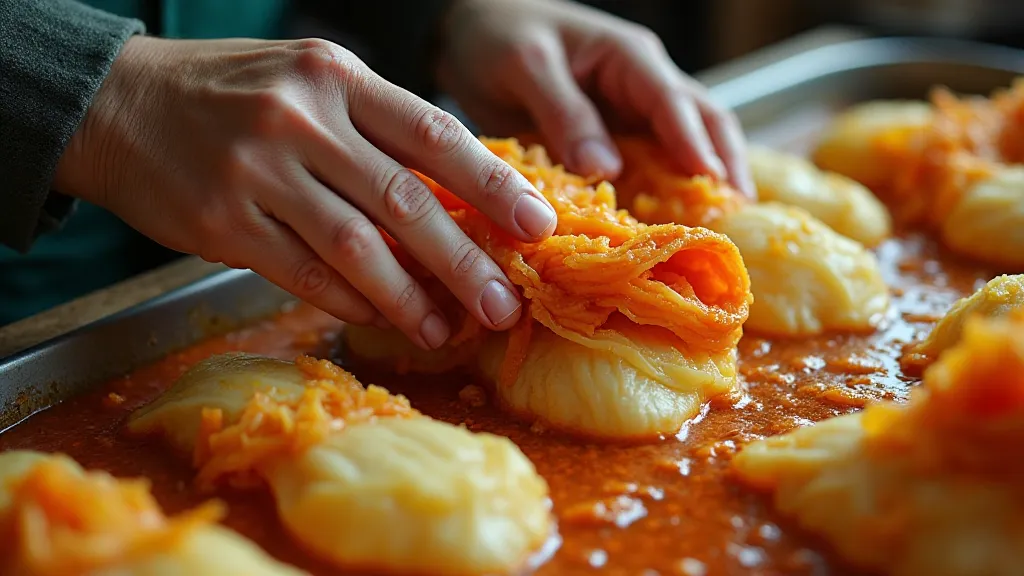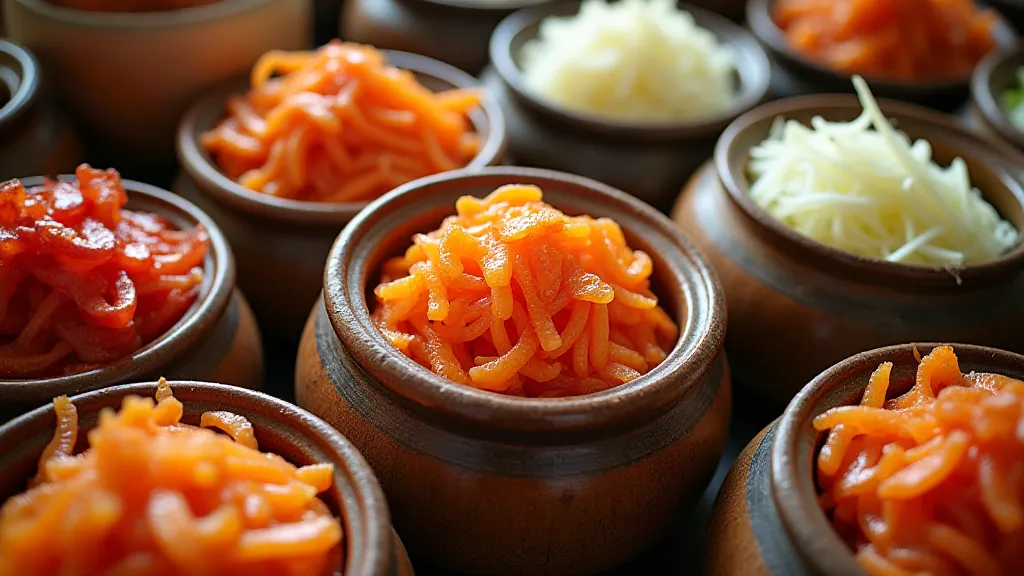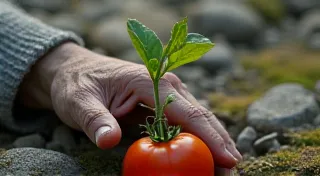The Silent Language of Fermentation: Korean Kimchi as a Cultural Keystone
The aroma hits you first. Not pungent, not unpleasant, but a complex, earthy fragrance that speaks of generations past. It’s the smell of kimchi, a cornerstone of Korean food traditions, a silent language whispered across centuries, and a tangible embodiment of Korean culture itself. Beyond being a delicious side dish, kimchi is a cultural keystone, intimately woven into the fabric of Korean history, social rituals, and familial bonds.
My first true understanding of kimchi’s significance didn't come from a cookbook or a documentary. It came from the kitchen of my Korean-American grandmother, Halmeoni. I was a young boy, awkward and unsure, fumbling with the unfamiliar tools and ingredients. Halmeoni, her hands weathered by decades of labor, patiently guided me, her smile radiating warmth and a quiet pride. It wasn't merely about making kimchi; it was about participating in a legacy, a connection to the ancestors who had perfected this art form over centuries.

A History Steeped in Necessity and Resourcefulness
The story of kimchi isn’t a straightforward tale of refined culinary artistry. It’s a story born of necessity, of resourcefulness in a land where preserving food was crucial for survival. Historically, Korea’s short growing seasons and harsh winters demanded innovative ways to store vegetables. Before refrigeration, salting and fermenting vegetables – primarily cabbage, radish, and scallions – became the primary means of extending their lifespan. Early versions of kimchi were much simpler, relying solely on salt and natural fermentation. The addition of chili peppers, a relatively late introduction via trade with the Americas, dramatically altered the flavor profile and solidified kimchi’s fiery character.
The Joseon dynasty (1392-1897) saw a significant evolution in kimchi production. Different regions began to develop their own unique styles, influenced by local ingredients and preferences. This regional diversity is still evident today, with kimchi variations ranging from the milder Baek kimchi (white kimchi) of the capital region to the pungent, fermented radish kimchi (kkakdugi) of Jeolla province. The concept of adapting cooking techniques to the available local ingredients and landscape echoes the resourcefulness needed to survive, much like the farmers in Sicily have perfected their methods in From Fields to Feasts: The Unseen Labor in Sicilian Citrus Bounty, shaping their cuisine through generations of adaptation.
The dedication to utilizing what's readily available and transforming it into something sustaining and flavorful is a recurring theme in culinary traditions worldwide. It’s a mindset of respect for the land and a deep understanding of its gifts, a quality that resonates deeply within Korean culture and its approach to food preservation.
Beyond the Ingredients: Ritual and Connection
Making kimchi isn't a solo endeavor. Traditionally, it's a community event, a kimjang, that brings families, neighbors, and even entire villages together. Women, primarily, participate in the kimjang, a testament to the historical role of women in food preservation and household management. These gatherings are far more than just a collective cooking session; they are vital social rituals that reinforce community bonds, transmit cultural knowledge, and celebrate shared heritage. The laughter, the stories exchanged, the sheer physicality of the labor – all contribute to a sense of belonging and continuity.
The process itself is steeped in symbolism. The precise measurements of salt and chili powder are passed down through generations, each family guarding their own secret recipe. The rhythmic pounding of the Napa cabbage, the folding and layering of the ingredients – it's a dance of tradition, a reaffirmation of identity.
My Halmeoni never shared her precise recipe, claiming it was “too sacred” to write down. She would simply guide me, demonstrating the subtle nuances of the process, relying on touch, smell, and instinct rather than rigid instructions. That, I realized, was the essence of the tradition – the intangible knowledge that transcends words, the connection to something larger than oneself. The careful passing down of culinary secrets and techniques, preserving not just recipes but the very essence of a cultural identity, is something deeply felt across the world, often tied to the land itself, as explored in The Echo of Ancestors: How Soil Shapes Taste in Appalachian Cooking. It’s a way of honoring the past and ensuring its continued existence.
Regional Variations: A Tapestry of Flavors
The beauty of Korean cuisine lies in its incredible diversity. Just as Italian cuisine varies significantly from region to region, so too does kimchi. The climate and available resources shape the flavors and techniques used in each area.
In Jeolla province, considered the culinary heartland of Korea, kimchi is particularly prized. Here, the emphasis is on bold, pungent flavors, often incorporating fruits like persimmon or apple for sweetness and depth. Gyeongsang province, on the southern coast, favors seafood-infused kimchi, using anchovies, shrimp, or even oysters to create a uniquely briny character. Gangwon province, in the mountainous northeast, often incorporates buckwheat, reflecting the region’s agricultural staples.

Even the types of cabbage used vary. While Napa cabbage is the most common base, other vegetables like Korean radish (mu), cucumber, and green onions are also transformed into delicious kimchi variations. These regional nuances are a testament to the adaptability and creativity of Korean cooks. The influence of trade routes and cultural exchange on cuisine is undeniable; the infusion of new ingredients and techniques shapes the culinary landscape just as profoundly, mirroring the vibrant blend of traditions observed in Echoes of the Silk Road: Uyghur Cuisine and the Fusion of Cultures. The very essence of a region’s identity can be captured in its flavors.
The careful consideration of available resources, the adaptation of methods, and the transmission of knowledge, all intertwine to create a complex and flavorful tapestry. Every bite of kimchi tells a story of resilience, innovation, and a deep connection to the land.
The Enduring Significance: More Than Just Food
Kimchi isn't just a dish; it’s a symbol of Korean resilience, ingenuity, and community. It’s a living embodiment of Korean history, a tangible link to the past, and a vibrant expression of Korean culture.
The globalization of Korean food has brought kimchi to the world stage, but experiencing it in its traditional context, participating in a kimjang, or simply sharing a bowl with family and friends – that is where its true magic lies. It’s a taste of home, a reminder of where we come from, and a celebration of the enduring power of food to connect us all.
My Halmeoni is gone now, but the aroma of kimchi still fills my memory, a silent language whispered across generations, a reminder of the enduring legacy of Korean food traditions. And each time I taste it, I am transported back to her kitchen, surrounded by the warmth of family and the rich tapestry of Korean culture. It’s a flavor that transcends words, a taste of heritage, and a testament to the enduring power of a simple fermented vegetable.
The dedication to preserving culinary traditions and understanding the vital link between food and landscape mirrors the careful attention to detail found in many cultures around the world, and just as the alpine meadows of Switzerland shape its distinct dairy culture, as described in A Pastoral Chorus: The Dairy Delights of Switzerland and the Landscape They Reflect, the Korean peninsula has forged its unique culinary identity through generations of resourcefulness and respect for the land. This intricate connection highlights the profound influence of geography and climate on human experience.
The transmission of knowledge and the preservation of traditions are cornerstones of any culture, and the aroma of kimchi continues to evoke a deep sense of connection to my Korean heritage, reminding me of the enduring legacy of family, community, and the simple pleasures of a shared meal.






